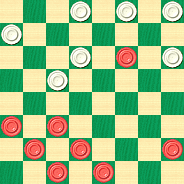The Checker Maven
Jump to navigationBasic Checkers Part Eight

Many of us believe that Jim Loy never sleeps, for this Bozeman, Montana-based Renaissance man is so prolific and turns out so much high-quality work that we can't believe there are enough hours in the day for him to get it all done. But he does, and though he's never revealed his secret, we're most happy and appreciative to benefit from his efforts.
What does Jim do? A visit to his website, jimloy.com, will tell you--- Jim does everything. From bowling to chess to tennis to billiards, there seems to be little that doesn't interest him, and he does nothing halfway. Fortunately for us, Jim takes a serious interest in checkers, too, and has lately been working on a series of projects aimed at restoring and correcting the classic works of the game.
Jim's checker books sell for a relatively nominal price on the American Checker Federation website. You'll find problem books, game books, and more; but today we want to focus on Jim's newest work, Basic Checkers Part 8: Corrections.
If you've read The Checker Maven for the past few months, you'll know that we recently participated in a reissue of Richard Fortman's seminal work, Basic Checkers. In our reissue, we reproduced the book with its original content; while we corrected obvious typos and other errors, we did not update or correct the actual game play. Mr. Loy's new book does exactly that; he provides us with just under a hundred pages of corrected or alternative lines of play. The book is the culmination of an effort Jim began in 2006, and gathers together work originally published in the ACF Bulletin as well as new work.
As an illustration, and also as this week's problem position, let's look at play in the 11-15, 22-17, 9-13 opening (taken from Part 8, page 57, note I).
11-15 22-17 9-13 17-14 10x17 21x14 8-11 23-19 15-18 19-15 4-8 24-19 6-10 15x6 1x17 25-21---A 17-22 26x17 13x22 27-23 18x27 32x23; forms diagram.

BLACK
Black to Play and win
B:W31,30,29,28,23,21,19:B22,12,11,8,7,5,3,2.
A---26-22 or 25-22 draw instead.
Black wins here in an unexpected and quite sophisticated manner. Finding the win may prove a difficult problem, but this one is good enough to merit considerable effort. So do try to work it out and then click on Read More for the solution and notes.![]()
Solution
22-26---B 31x22 11-16 21-17 8-11---C 22-18 16-20 17-13 11-16 13-9 5x14 18x9 20-24 19-15 24-27 23-18 27-31 18-14 31-27 29-25 27-23 25-21 23-18 15-10 18-22 10-6 22-17 6-1 17x10 Black Wins---D.
B---A most unexpected move that will yield a win some 14 moves later.
C---Part 8 gives 7-10 to win but the KingsRow engine prefers 8-11. See Part 8 for the alternative continuation.
D---A fascinating win; Black paralyzes most of the White pieces and finally goes up a man to win the game.
You can email the Webmaster with comments on this article.
